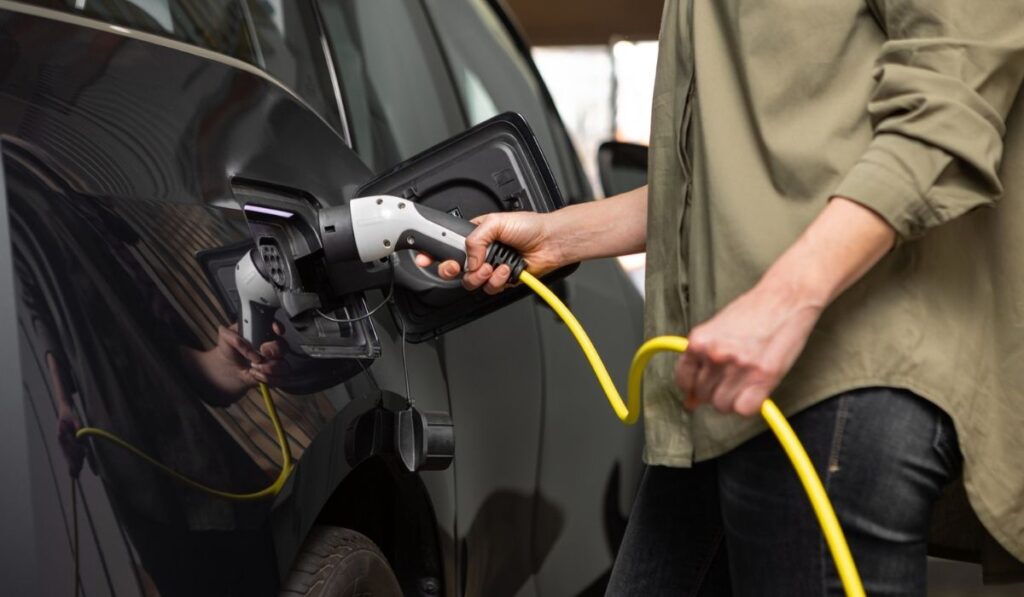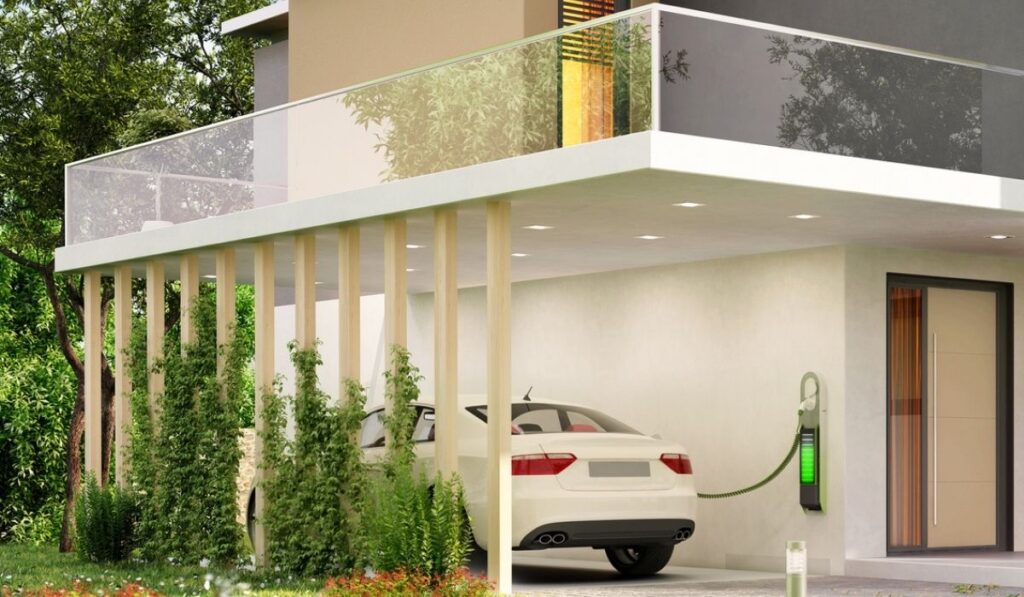Electric vehicles are becoming more popular, affordable, and available for the average consumer. Despite this, there’s still an air of mystery surrounding the way electric vehicles (EVs) are used. One frequently asked question is, “Can you charge an electric car at home?”
You can charge an EV at home, and most electric cars include a standard 3-pin 120-volt portable charger that can connect to normal outlets. These included chargers are slow, taking as much as 24 hours to charge fully, so most EV owners install “Level 2” chargers which charge roughly 10x faster.
Don’t be deterred by the idea of installing an additional piece of equipment to charge your electric vehicle. You might not even need a more powerful charger; it depends on your car, commute, and driving habits. Here’s what you need to know about charging EVs at home and the options available.
Can You Charge Your EV at Home?

Yes, it’s possible to charge an electric vehicle at home, and it’s one of their biggest advantages. Generally speaking, you have two main options for charging an electric vehicle. You can either use the standard 3-pin charger that’s included with the vehicle or get a dedicated home charger installed.
Typically, a dedicated home charger is the preferred option. These chargers are usually faster, more reliable, and very convenient.
Can You Plug an Electric Car Into a Regular Outlet?
Yes, it’s possible to plug an electric car into a standard home outlet and receive a charge. As we mentioned, most electric vehicles come with a standard 3-pin 120-volt portable charger. However, these chargers are incredibly slow and generally get used as a last resort.
The standard 3-pin charger can take upwards of 24 hours to fully charge an EV. Most manufacturers recommend installing a dedicated EV charger and using the included charger only as a backup.
How to Charge an Electric Car at Home
Electric vehicle chargers are broken down into levels 1 through 3, with higher levels offering more power (and a faster charge). Generally speaking, residential homes can only utilize levels 1 and 2, so we’ll focus on those.
Level 1 Charger
Most electric vehicles include a Level 1 portable charger when you purchase them. These chargers typically contain a 3-pin 120-volt charger and are compatible with everyday household outlets. Level 1 chargers are the slowest option available and provide anywhere between 3 and 5 miles of range per hour.
Advantages
- Included with the electric vehicle
- Convenient; can be used with any household outlet
- Portable
Disadvantages
- Extremely slow charge time
- Not designed for most daily charging requirements
The main disadvantage to Level 1 chargers is that they’re really slow. Level 1 chargers can take 24 hours to fully charge an EV. Furthermore, electric vehicle batteries are getting larger, making these chargers even less viable.
Level 1 chargers are typically considered trickle chargers and aren’t frequently used as a primary charger.
Best Use Cases
Although they’re slow, Level 1 chargers do have some scenarios where they work well. For example, Level 1 chargers work well for plug-in hybrid electric vehicles (PHEVs) as these models have smaller batteries that require lower charge times.
Level 1 chargers can also be used if you don’t drive very often or have a very short commute. These chargers can also be used to add enough juice to your car so that you can get to a fast-charging station if needed.
Another way you can use Level 1 chargers is by keeping them as a backup option. They’re typically small enough to fit in a backpack, making them easy to transport. You could take this charger with you to a friend’s house or on a long trip as an extra safety net.
Level 2 Charger
Level 2 chargers are generally the preferred option for daily EV charging. These chargers can be installed in residential areas, workplaces, and public spaces. Level 2 charging can provide anywhere between 12 and 80 miles of range per hour, depending on the power level and the vehicle.
These chargers typically have 240 volts and need to be professionally installed.
Advantages
- Charges EVs up to 10 times faster than Level 1 chargers
- Charges between 12 and 80 miles of range per hour
- Can usually charge a vehicle overnight to completion, even if the battery is nearly empty
- Readily available
- Multiple options and products to choose from
Disadvantages
- Expensive upfront costs ranging anywhere from $200 to over $2,000
- Some options need to be professionally installed
- Some systems can’t be taken with you if you move to a new home
The main downsides to Level 2 chargers are the upfront costs, installation requirements, and the inability to take some systems with you if you move. All that aside, Level 2 chargers are still the preferred option for most electric vehicle owners.
So You’ve Decided to Purchase a Level 2 Charger…
Most new electric vehicle owners want to upgrade to a Level 2 charger as soon as possible. These chargers are the preferred option and are seen as a necessity for many EV users.
However, there are a few things you should keep in mind before you get your own Level 2 charger.
Costs
You’re probably going to have to spend a fair amount to on your Level 2 electric vehicle charger and its installation, though the prices vary widely. For example, the Grizzl-E Level 2 EV Charger (on Amazon) costs under $500, while the Tesla Motors Charger (also on Amazon) costs closer to $800.
There are many different models available with various features, capabilities, and specifications. Some models offer smart features such as Amazon Echo or Google Assistant. Other Level 2 chargers are better suited for the outdoors, and some have extra long cables.
You’ll need to factor in the costs as well as the features when determining which Level 2 charger is best for you. You might want a charger with smart features. Or you might be more concerned with more practical matters like the chord length, durability, and design.
Installation
Generally speaking, you’ll need to have a Level 2 charger installed by a professional electrician. Most Level 2 chargers require a 240-volt circuit. If your home already has a 240-volt circuit, the installation fee might cost you around $250 to $400, excluding the charger itself.
On the other hand, if you decide to mount a station and run 50-amp dedicated wiring, you could be looking at anywhere from $400 to $1,700. Depending on the project, you could end up spending several thousand dollars for a new station, service panel, wiring, and a 240-volt outlet.
This number could be even higher if the installation requires extensive wiring, trenching, or running additional conduit.
In total, you could be looking at anywhere from $400 to over $4,000 depending on the Level 2 charger model, the scope of the project, the company doing the installation, and other variables.
You Might Need Permits
In some cases, you might need permits to install a Level 2 charger in a residential home. Your charging station might need to adhere to federal, state, and local building codes.
The federal government requires installations to follow the National Electric Code (NEC). Building and electrical permits are common requirements in most states.
Depending on your local jurisdiction, permits could add anywhere from $50 to just above $160 to your total.
What Is the Battery Life of Electric Cars?
EV batteries have a limited lifespan, just like any other battery. Electric vehicles use lithium-ion batteries that degrade over time due to age, use, and maintenance conditions.
Most electric vehicle batteries are estimated to last between 10 and 20 years before they need to be replaced. However, some estimate the battery life to be between 65,000 and 100,000 miles.
The Cost of a New Battery
Concerns about dead batteries and aging components are reasonable. Electric car battery packs are generally the most expensive component of the car.
The batteries can cost around $5,000 on average and upwards of $15,000 in some cases. Thankfully, with improvements to lithium-ion technology, this price is expected to drop over time.
Which Factors Affect an Electric Car Battery?
As mentioned earlier, electric car batteries degrade over time. The lithium-ion battery packs are affected by the climate, charging conditions, and other factors.
These elements can drain your EV battery and reduce its lifespan in the process.
Climate and Temperature
Climate and temperature levels can severely impact lithium-ion batteries. For example, high levels of heat can negatively impact the battery lifespan over long periods of time.
Very low temperatures can also impact the battery, mostly on a short-term and performance level.
Keeping your battery cool and out of temperature danger zones is one way to preserve its lifespan and longevity.
Charging Frequency
Charging frequency and methods can also affect lithium-ion batteries. Frequent sessions of short charge times can negatively impact the electric car battery over long periods.
Frequent charging also generates more heat, which can result in unnecessary wear and tear over the long run.
Other Factors
Other factors can also affect lithium-ion batteries and electric cars. Car accidents can severely impact the battery life or surrounding components, reducing performance and longevity in the process.
Neglecting different performance features and safety modes may also increase battery degradation over time. Poor driving habits or leaving the car idle can also affect an electric vehicle’s battery lifespan.
Best Practices to Maintain EV Battery Life

Lithium-ion batteries have come a long way over the past decades. These batteries have extended lifespans, increased safety, and lower price tags.
But just like any piece of hardware or technology, you have to treat them with care. Here are some best practices to follow to extend and maintain your EV battery lifespan.
Avoid Charging Every Night
You put stress on an EV battery every time you hook it up to the charger. This stress can reduce the capacity and lifespan by a fraction, compounding overnight.
It’s best to avoid charging your electric car battery every night. It doesn’t matter if you’re topping it off or charging the vehicle to completion. Instead, try to charge the vehicle when necessary and avoid plugging it in as soon as you get home.
Keep It Charged Between 20 and 80 Percent
Lithium-ion batteries are made to store large amounts of energy that varies and changes. Frequently draining the battery or charging it to completion can reduce its capacity, longevity, and performance.
It’s best to avoid charging your EV battery to 100 percent when you don’t need to. The common rule of thumb is to stay in the 20 to 80 percent range and never let the battery drain completely.
Keep It Charged During Storage
Leaving your electric vehicle parked for long periods with a full or empty battery can have negative impacts over time. This means if you’re not using your electric car for a significant amount of time, it’s best to leave it charged between 25 and 75 percent.
This way, the lithium-ion battery can run its natural course without fully draining. Not to mention, there are smart charging stations and products that can ensure your vehicle doesn’t go beyond these restrictions.
Keep It Cool
High temperatures can negatively impact an EVs battery lifespan. On the flip side, colder temperatures and climates can decrease the performance. There’s no one-size-fits-all answer for every EV make, model, and manufacturer. However, keeping your EV cool might prevent unnecessary damage over time.
You should try to park your vehicle under the shade or in a covered garage if possible. Sun covers are another viable consideration.
Generally speaking, if the temperatures are above 80 degrees Fahrenheit, you should take proper safety measures to ensure the longevity of your vehicle and battery.
